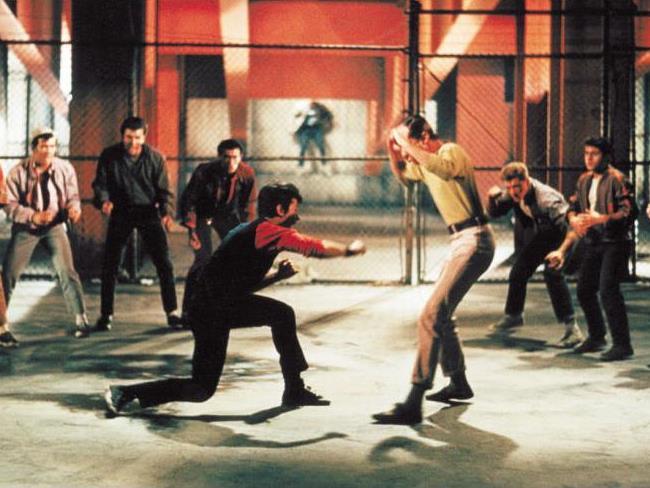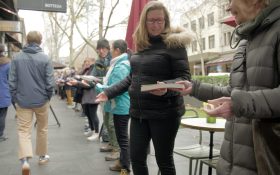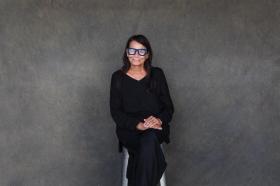The Sharks and the Jets rumble in United Artists’ West Side Story (1961).
It would astound most Australians to know that, in the language of dollars alone, our national arts ambitions haven’t evolved beyond the plucky desire of a colony to impress its visiting queen.
Financial commitments first made in the 1950s to hastily convened opera, theatre and ballet companies made for a very proper royal visit – and continue to this day.
Meanwhile, Australia’s regional and urban centres had already been establishing world class galleries for a hundred years, and Australia’s First Peoples had been creating the images and objects that nurture a unique culture for tens of thousands of years.
And yet we still have this situation where 62% of the Australia Council’s $177.1 million budget goes to the Major Performing Arts (MPA) in uncontested recurrent funding – which is currently under review. That’s $109.1 million for 28 companies as of 2016-17, while less than half that sum – $53.4 million – is granted to 590 small-to-medium organisations as the result of highly competitive funding programs.
That disparity is best expressed in the language of dollars alone because, in a situation where no arts strategy has ever survived political change, no one has ever dared document the unwritten policy that the performing arts are more important than contemporary visual arts. Only $4.2 million goes to the nation’s 28 leading contemporary arts organisations as part of the Visual Arts and Craft Strategy (VACS).
It’s often argued that the funds quarantined to the Major Performing Arts are justified by audience development. Not so. That’s debunked by the massive audiences of the small-to-mediums: 9.5 million people compared to the MPA’s four million and shrinking. As for audience development, how are those majors marketing to reach new audiences? Through millions spent on outdoor advertising, online cookies and in-house journalism, paying former professional journalists to write profiles and reviews – while arts journalism in Australia languishes, leaving little space for the rigorous independent critique that feeds the Australian culture. Quarantined funding; quarantined audiences; quarantined critique.
Don’t get me wrong. The majors-independents street fight isn’t good for the arts and it’s not one I’m interested in fuelling.
After all, I love opera. I love the bold experimentations of Chamber Made, or the rigorous approach of the Present Tense Ensemble. I’m invigorated by the exciting way they combine unexpected objects with moving images and the power of the human voice. That’s what opera means in Australia today.
I love music. I love the complex instrumentation of Speak Percussion, or the biotechnical light and sound of SymbioticA. I’m inspired by their global impact, and constantly astounded that their international reputations are far stronger than their Australian recognition. That’s what music means in Australia today.
I love the performing arts. I’m deeply impressed by ILBIJERRI Theatre. My mind feels enlarged by the work of pvi collective and Field Theory. Consistently and with sophistication, they ask new questions through work performed in collaboration with audiences. That’s what performance means in Australia today.
None of these companies would be eligible for consideration as an MPA. In fact, most of these companies create work in that exciting space that’s commonly called ‘contemporary arts’. Sound, light, image, movement, craft, design, live art, new objects, unexpected technologies, sophisticated biologies. Their work is presented in galleries and in public spaces. It’s researched and critiqued by academics at centres of excellence and in ARC Linkage Grants, enriching the national understanding of what creative practice means in Australia today.
It’s up to artists tell us what art forms are and where they’re going. To explode our thinking, question our ethics and foster our communities. To offer platforms for understanding our human potential and our shared future.
This week’s Meeting of Cultural Ministers officials have the opportunity to be ambitious. The people who support the Meeting of Cultural Ministers are thinking through a lot of policy matters – including the future for the MPA and VACS.
It’s time to evolve. Companies who comprise the diverse MPAs such as the trailblazers at the Belvoir and those adventurous mavericks at Circus Oz will soon be joined by the successful Victorian Opera. VACS could also start to be considered in that long-term funding framework.
If the security of long-term funding is seen as being effective for creating great new work, then let’s extend that confidence beyond the Major Performing Arts to where the innovation lies. Rather than quarantining the imported arts of the past, let’s quarantine the mindset that creates the adventurous Australian art of the future.
Let’s reward the diversity we see on gallery walls and floors – and see how opening that conversation could help us start to see that diversity on our mainstages.
Let’s set Australia’s contemporary artists a challenge – one based on deep respect. To borrow the failure manifesto, evolve and evolve again.
After all, there’s more at stake here than the sustainability of a few dozen arts companies.
The future of the Australia Council itself is at stake if it can’t determine an operating model that moves beyond disproportionate support for few companies. The weakening of the entire sector after the past few years’ cuts warrants urgent attention via ambitious, expert sector development initiatives. VACS, for example, is a nested set of commitments premised on the interdependency between artists, service organisations, galleries, artist-run initiatives and key events. There’s certainly room for improvement – but such work builds on strong foundations.
In the light of the Royal Commission into financial sector misconduct, and the Parliamentary Inquiry into public interest journalism, sector development will mean more than just program and audience. The future of Australia’s arts will depend heavily upon high-quality, ethical governance, as well as cultural investigation and meaningful critique by a strengthened independent media.
The consequences of a weakened cultural sector affect everyone – even the quarantined companies. The solution must involve everyone.
Let’s mature the national contemporary arts conversation. And if we’re still hell bent on impressing any visiting Windsors, Middletons and Markles, then let’s show them a confident Australia creating its own unique culture.





